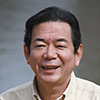If the camera you are using is one that is good for photographing at high ISO speeds, you will be able to produce clear shots in a low-light scene without causing camera shake or resulting in out-of-focus images. In this article, I will introduce some techniques for photo shoots at a night zoo. (Reported by: Toyofumi Fukuda)

Pages: 1 2
Close-up Shot of a Lion Illuminated by Mercury Lamps
With the advent of cameras that support high ISO speed shooting in recent years, you can now capture photos at a night zoo, which could not be done in the past. Animals that show up in the dark night under low light appear commanding and yet bewitching. Their sharp and majestic looks are expressions that can only be seen at night. In Japan, zoos generally extend their operating hours in summer till 8 or 9 pm. Since darkness only sets in at around 7 pm, the time left for night shoot is extremely short. Although there are many good subjects, taking a shot may be more time-consuming than expected if you are waiting for the right photo opportunity. The wise way, therefore, is to narrow down your target subjects, and take your time to photograph different subjects each day, such as wolves for day one and tigers for day two.

ISO 12800
EOS-1D X/ EF300mm f/2.8L IS II USM/ FL: 300mm/ Aperture-priority AE (1/160 sec., f/2.8, -1.7EV)/ ISO 12800/ WB: Auto
The surroundings were brightened by a mercury lamp, which added a green colour cast to the image. Here, I adjusted the white balance during the development stage to a colour close to that of a lion. The tool used in this example is Click White Balance available in the Digital Photo Professional (DPP) software.

ISO 400
Using a low ISO speed causes the shutter speed to slow down, so the slightest movement of the subject would result in a blurry image. In order to maintain a fast shutter speed, a high ISO speed setting would therefore be necessary.
Technique – Set to decreased exposure when using AE

±0EV

-1EV

-2EV
As illustrated in the examples, taking a photo without exposure compensation results in a rather bright image, which does not convey the impression of a night shot. In this case, setting to a decreased exposure of -1 to -2EV helps to enhance the atmosphere considerably.
Adding Dimensionality to the Monkey Mountain with Light from the Side

ISO 10000
EOS-1D X/ EF16-35mm f/2.8L II USM/ FL: 35mm/ Aperture-priority AE (1/10 sec., f/3.5, -1.3EV)/ ISO 10000/ WB: Auto
A man-made monkey mountain for the Rhesus monkeys. Unlike daytime, they hide themselves in the mountain at night, and the surroundings are so quiet one can hardly sense their presence.
Adjusting the White Balance for a Bluer Sky

ISO 10000
EOS-1D X/ EF16-35mm f/2.8L II USM/ FL: 35mm/ Aperture-priority AE (f/3.5, 1/10 sec., -1.3EV)/ ISO 10000/ WB: Tungsten light
Flamingos in this zoo are left to move around freely without the use of a net, making it possible to capture this fantastical shot at the golden hour.

ISO 800
When white balance is set to Auto, the sky is reproduced in a dark grey tone, while the light source added a red cast that does not match the impression of the flamingos. Changing the white balance setting to Tungsten Light helps to create a fantastical atmosphere.
The use of flash light is prohibited at the night zoo, so we can only rely on the lightings in the premises. A high ISO speed is a must in this case. Even then, you might not be able to obtain a sufficiently fast shutter speed. Although a slower shutter speed can be chosen if you are using a tripod, setting up a tripod would cause inconvenience to other visitors, and most importantly, the slow shutter speed would cause the subject to turn out blurry. To counter these problems, try using the tripod as a monopod instead, or prevent camera shake by placing the camera on a railing, for example.

Animal photographer. Born in Saga in 1955, Fukuda devotes his efforts to a wide range of genres from pets to wildlife. President of the UFP Photo Office and a member of the Japan Professional Photographers Society (JPS).

A monthly magazine that believes that enjoyment of photography will increase the more one learns about camera functions. It delivers news on the latest cameras and features and regularly introduces various photography techniques.
Published by Impress Corporation

































